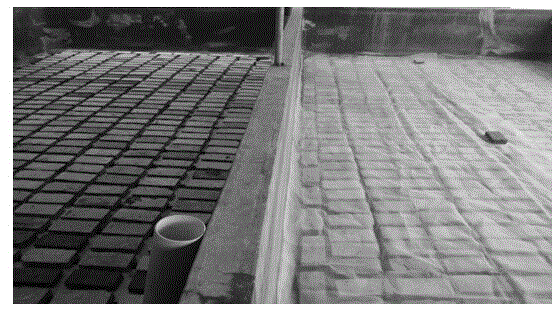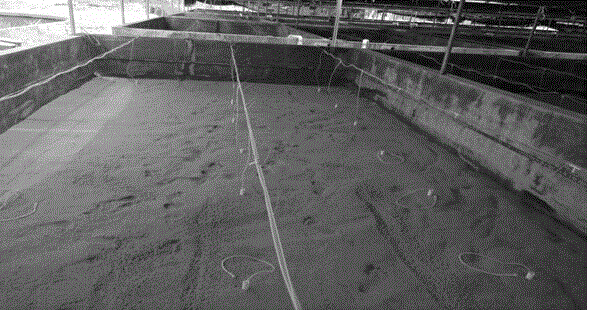Method for intermediate cultivation of juvenile lutrariasieboldii reeve in outdoor cement pond
A technology of intermediate cultivation and breeding method, which is applied in the field of aquatic animal breeding, can solve the problems of difficulty, over-breeding of unicellular algae bait, and affecting the normal growth of elephant-nosed mussels, and achieve low cost, easy control of water quality, and improvement of feeding effect Effect
- Summary
- Abstract
- Description
- Claims
- Application Information
AI Technical Summary
Problems solved by technology
Method used
Image
Examples
Embodiment 1
[0026] (1) Set up the breeding pond: set up an overhead breeding bed at the bottom of the cement breeding pond, and the breeding bed is composed of a support frame, a sand layer and ancillary facilities. The supporting frame is erected with two layers of red bricks, the height is 12cm, and it is a bridge structure. There are gaps around each brick for water permeability; the supporting frame is covered with a 60-mesh screen, and sea sand with a particle size of 1mm is laid on the mesh, and the sand layer is 5mm thick. centimeter; the auxiliary facility is a pneumatic device, which consists of a batch of inflatable intubation tubes with a diameter of 1 inch, a length of 20cm, and a density of 3m 2 / pipe, the intubation tube extends from the sand surface through the screen to the bottom of the pool, and the part that enters the bottom of the pool is bifurcated as a water inlet. One air-dispersing stone is placed in each intubation tube. When inflated, the gas lift of the air bubbl...
Embodiment 2
[0033] (1) Set up the breeding pond: set up an overhead breeding bed at the bottom of the cement breeding pond, and the breeding bed is composed of a support frame, a sand layer and ancillary facilities. The support frame is erected with two layers of red bricks, with a height of 12cm and a bridge structure. There are gaps around each brick for water permeability; a 60-mesh screen is laid on the support frame, and sea sand with a particle size of 2 mm is laid on the net, and the sand layer is 10 thick. centimeter; the auxiliary facility is a pneumatic device, which consists of a batch of inflatable cannula with a diameter of 1 inch, a length of 25cm, and a density of 3m 2 / pipe, the intubation tube extends from the sand surface through the screen to the bottom of the pool, and the part that enters the bottom of the pool is bifurcated as a water inlet. One air-dispersing stone is placed in each intubation tube. When inflated, the gas lift of the air bubbles will The water body ...
Embodiment 3
[0040] (1) Set up the breeding pond: set up an overhead breeding bed at the bottom of the cement breeding pond, and the breeding bed is composed of a support frame, a sand layer and ancillary facilities. The supporting frame is erected with two layers of red bricks, with a height of 12cm and a bridge structure. There are gaps around each brick for water permeability; a 60-mesh screen is laid on the supporting frame, and sea sand with a particle size of 2mm is laid on the mesh, and the sand layer is 8mm thick. centimeter; the auxiliary facility is a pneumatic device, which consists of a batch of inflatable intubation tubes with a diameter of 1 inch, a length of 22cm, and a density of 3m 2 / pipe, the intubation tube extends from the sand surface through the screen to the bottom of the pool, and the part that enters the bottom of the pool is bifurcated as a water inlet. One air-dispersing stone is placed in each intubation tube. When inflated, the gas lift of the air bubbles will ...
PUM
 Login to View More
Login to View More Abstract
Description
Claims
Application Information
 Login to View More
Login to View More - R&D
- Intellectual Property
- Life Sciences
- Materials
- Tech Scout
- Unparalleled Data Quality
- Higher Quality Content
- 60% Fewer Hallucinations
Browse by: Latest US Patents, China's latest patents, Technical Efficacy Thesaurus, Application Domain, Technology Topic, Popular Technical Reports.
© 2025 PatSnap. All rights reserved.Legal|Privacy policy|Modern Slavery Act Transparency Statement|Sitemap|About US| Contact US: help@patsnap.com



